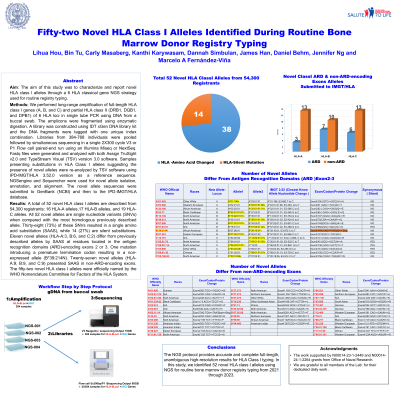Back

Fifty-two Novel HLA Class I Alleles Identified During Routine Bone Marrow Donor Registry Typing
(P502) Fifty-two novel HLA class I alleles identified during routine bone marrow donor registry typing
Location: Platinum Ballroom

Poster Presenter(s)
Aim: The aim of this study was to characterize and report novel HLA class I alleles through a 6 HLA classical gene NGS strategy used for routine registry typing.
Method: We performed long-range amplification of full-length HLA class I genes (A, B, and C) and partial HLA class II (DRB1, DQB1, and DPB1) of 6 HLA loci in single tube PCR using DNA from a buccal swab. The amplicons were fragmented using enzymatic digestion. A library was constructed using IDT xGen DNA library kit and the DNA fragments were tagged with one unique index combination. Libraries from 384-768 individuals were pooled followed by simultaneous sequencing in a single 2X300 cycle V3 or P1 Flow cell paired-end run using an Illumina Miseq or NextSeq. Fastq files were generated and analyzed with both Assign TruSight v2.0 and TypeStream Visual (TSV) version 3.0 software. Samples presenting substitutions in HLA Class I alleles suggesting the presence of novel alleles were re-analyzed by TSV software using IPD-IMGT/HLA 3.52.0 version as a reference sequence. NGSengine and Sequencher were used for novel allele isolation, annotation, and alignment. The novel allele sequences were submitted to GenBank (NCBI) and then to the IPD-IMGT/HLA database.
Results: A total of 52 novel HLA class I alleles are described from 54,300 volunteer donors included: 16 HLA-A alleles,17 HLA-B alleles, and 19 HLA-C alleles. All 52 novel alleles are single nucleotide variants (SNVs) when compared with the most homologous previously described allele. Thirty-eight (73%) of these SNVs resulted in a single amino acid substitution (SAAS), while 14 (27%) present silent substitutions. Eleven novel alleles (HLA-A:3, B:6, and C:2) differ from previously described alleles by SAAS at residues located in the antigen recognition domains (ARD)-encoding exons 2 or 3. One allele has a nucleotide replacement introducing a premature termination codon resulting in the non-expressed allele (B*39:214N). Twenty-seven novel alleles (HLA-A:9, B:9, and C:9) presented SAAS in non-ARD-encoding exons. The fifty-two novel HLA class I alleles were officially named by the WHO Nomenclature Committee for Factors of the HLA System.
Conclusion: The NGS protocol provides accurate, complete, and unambiguous HLA Class I results. We observed novel HLA class I alleles at a rate of approximately 1/1,000 in unrelated subjects using NGS for routine bone marrow donor registry typing from 2021 through 2023.
Method: We performed long-range amplification of full-length HLA class I genes (A, B, and C) and partial HLA class II (DRB1, DQB1, and DPB1) of 6 HLA loci in single tube PCR using DNA from a buccal swab. The amplicons were fragmented using enzymatic digestion. A library was constructed using IDT xGen DNA library kit and the DNA fragments were tagged with one unique index combination. Libraries from 384-768 individuals were pooled followed by simultaneous sequencing in a single 2X300 cycle V3 or P1 Flow cell paired-end run using an Illumina Miseq or NextSeq. Fastq files were generated and analyzed with both Assign TruSight v2.0 and TypeStream Visual (TSV) version 3.0 software. Samples presenting substitutions in HLA Class I alleles suggesting the presence of novel alleles were re-analyzed by TSV software using IPD-IMGT/HLA 3.52.0 version as a reference sequence. NGSengine and Sequencher were used for novel allele isolation, annotation, and alignment. The novel allele sequences were submitted to GenBank (NCBI) and then to the IPD-IMGT/HLA database.
Results: A total of 52 novel HLA class I alleles are described from 54,300 volunteer donors included: 16 HLA-A alleles,17 HLA-B alleles, and 19 HLA-C alleles. All 52 novel alleles are single nucleotide variants (SNVs) when compared with the most homologous previously described allele. Thirty-eight (73%) of these SNVs resulted in a single amino acid substitution (SAAS), while 14 (27%) present silent substitutions. Eleven novel alleles (HLA-A:3, B:6, and C:2) differ from previously described alleles by SAAS at residues located in the antigen recognition domains (ARD)-encoding exons 2 or 3. One allele has a nucleotide replacement introducing a premature termination codon resulting in the non-expressed allele (B*39:214N). Twenty-seven novel alleles (HLA-A:9, B:9, and C:9) presented SAAS in non-ARD-encoding exons. The fifty-two novel HLA class I alleles were officially named by the WHO Nomenclature Committee for Factors of the HLA System.
Conclusion: The NGS protocol provides accurate, complete, and unambiguous HLA Class I results. We observed novel HLA class I alleles at a rate of approximately 1/1,000 in unrelated subjects using NGS for routine bone marrow donor registry typing from 2021 through 2023.

